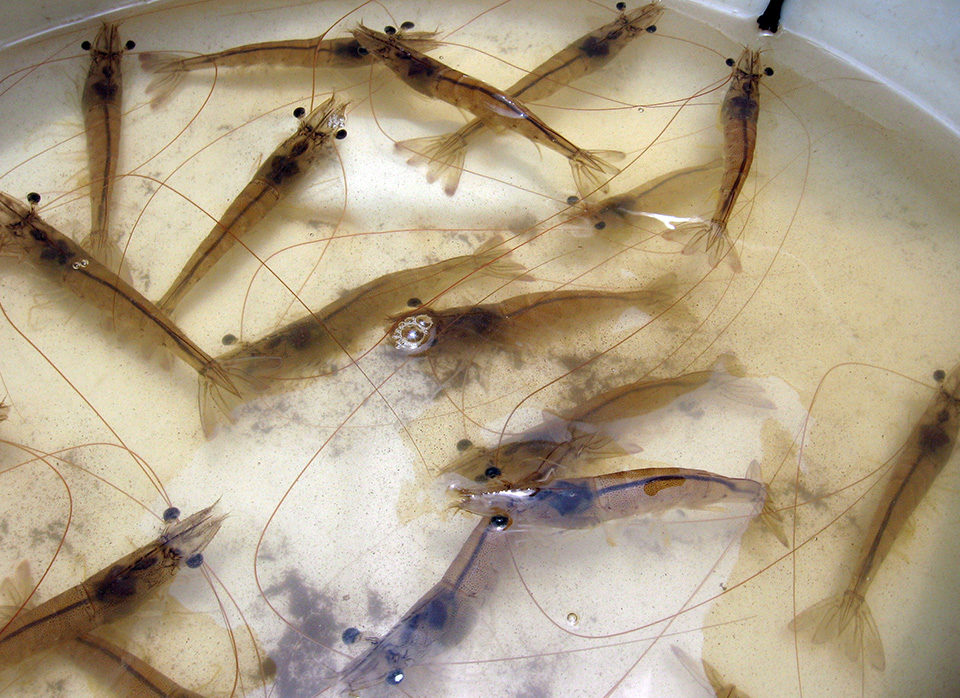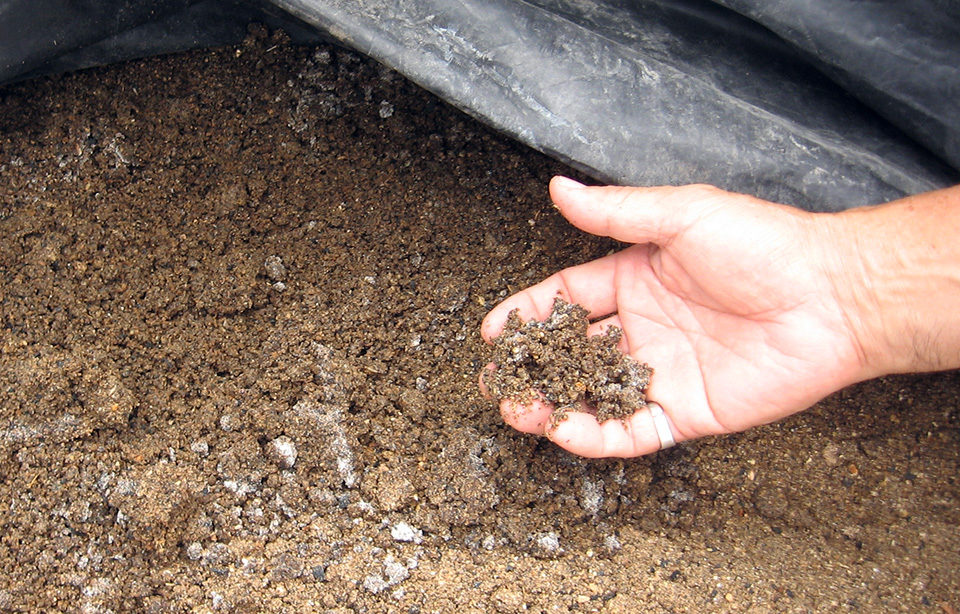Critical to understand physiological limitations, components of production

Every animal – be it a sponge or a whale – possesses some form of immunity. The differences between animals’ immunity systems are a function of complexity.
Vertebrates such as fish have evolved complex immune systems that allow the animals to produce proteins known as antibodies that are specifically targeted to seek structural components of potential pathogens. White blood cells coordinate this production and allow memory of the initial encounter to ensure more rapid response to subsequent encounters. Mammals have even more intricate systems, although many of the underlying mechanisms overlap.
Invertebrates, including shrimp, have also evolved sophisticated immune systems, although they do not produce antibodies and lack the ability to remember prior exposure to a pathogen, a critical component of long-term protective immunity. Shrimp are thought to have only non-specific immune systems.
Shrimp immunity research
Many published reports demonstrate the ability of various materials to enhance protective immunity in shrimp against challenges with virulent organisms under laboratory conditions. These materials typically are based on carbohydrate, (sugar) and include but are not limited to beta-glucans derived from yeast and fungi, lipopolysaccharides derived from gram-negative bacteria, peptidoglycans derived from gram-positive bacteria and a variety of sulfated polysaccharides derived from algae. Some protein-based materials may be protective, as well, although studies often have not shown that these materials were free of contaminating materials such as the aforementioned carbohydrates. Research is ongoing in this area.
Some of the earliest studies trying to protect shrimp against the bane of shrimp aquaculturists, pathogenic vibrios, were done using crude whole bacterial cell wall materials – essentially formalin-inactivated whole cell suspensions. The suspensions were found to provide a protective benefit against laboratory challenges, although the exact mechanisms for the observations are still not clear.
In the early 1990s, the first commercially available immunity-enhancing product was marketed by International Aquaculture Biotechnologies Ltd. (IABL) and extensively tested. Over the course of the product’s lifetime, the limitations for products of this nature became evident.
Some of the observations made both in published and non-published literature were that the protective benefit was not specific to the bacterial species contained within the product. In fact, a protective effect against viruses was observed. It was also noted that the duration and intensity of the effect were highly variable. Since the early products were applied primarily in the water, re-exposing animals was problematic.
With the advent of the yeast-based materials (mainly beta-glucans), this problem was addressed through application via feed. However, the same issues regarding the duration and intensity of the effect remained, and it soon became apparent that constant oral application had potential limitations.
Lab-testing limits
One of the problems with laboratory-based testing of these products is that this approach is not well suited to shrimp culture. Typically, shrimp are exposed to a pathogen in a clean laboratory environment free of stressors, where the only pathogenic assault is from the specific pathogen being tested.
The real world environment is completely different. It is very difficult to determine the impacts of repeated exposures to pathogens under the stressful conditions of production ponds.
The factors that impact survival in the field are complex and often not easily discernable. In fact, few shrimp farms can identify with certainty the underlying causes of mortality in a population throughout a production cycle.
While some diseases are easy to diagnose, many farms lose significant portions of their populations without seeing signs of disease or high levels of mortality. Given this situation, how can one determine in the field that a product really delivers a purported protective benefit to animals?

Cost-benefit decision
Ultimately the decision to use these products must come down to cost and risk-benefit analyses. Normal variable survivals in shrimp ponds make it a bit cumbersome to use correlative statistics to determine that something is providing a benefit. Furthermore, the absence of a scientifically valid model that explains the mechanisms of protection further clouds the issue.
Large-scale field trials with billions of animals and hundreds of ponds over the course of years were required for IABL to “prove” that a $0.05/1,000 postlarvae cost resulted in a 1 to 8 percent increase in survival. However, when highly virulent pathogens such as white spot syndrome virus or a newly mutated Taura syndrome virus strain struck, this cost benefit was lost. The observation that survival is higher in ponds containing animals exposed to non-specific immune stimulants cannot be consistent, as many factors impact survival.
Maintain perspective
It is not unreasonable to assume that as culture practices evolve, farmers become more adept at minimizing stress and genetic programs yield more stress- and pathogen-tolerant animals, a number of immunity-stimulating compounds will show indisputable real world benefits. Until then, farmers should maintain a healthy degree of skepticism and recognize that physiological limitations in shrimp immune systems and fundamental components of the production process are critical in determining the outcome of a given disease process.
While there is little doubt that a variety of materials can bolster the ability of shrimp to withstand some disease processes, the widespread use of “kitchen sink” mixtures of high-priced non-specific immune stimulants is probably not cost-beneficial. Some less-expensive compounds that add only a few dollars to the cost of a ton of feed, however, present little financial risk in return for potential benefits in shrimp health.
(Editor’s Note: This article was originally published in the July/August 2009 print edition of the Global Aquaculture Advocate.)
Now that you've finished reading the article ...
… we hope you’ll consider supporting our mission to document the evolution of the global aquaculture industry and share our vast network of contributors’ expansive knowledge every week.
By becoming a Global Seafood Alliance member, you’re ensuring that all of the pre-competitive work we do through member benefits, resources and events can continue. Individual membership costs just $50 a year. GSA individual and corporate members receive complimentary access to a series of GOAL virtual events beginning in April. Join now.
Not a GSA member? Join us.
Author
-
Stephen G. Newman, Ph.D.
President and CEO
AquaInTech Inc.
6722 162nd Place Southwest
Lynnwood, Washington 98037 USA
Tagged With
Related Posts

Health & Welfare
A holistic management approach to EMS
Early Mortality Syndrome has devastated farmed shrimp in Asia and Latin America. With better understanding of the pathogen and the development and improvement of novel strategies, shrimp farmers are now able to better manage the disease.

Health & Welfare
Aquaculture viruses: An Atlantic salmon case study
Viruses often are the most potentially damaging pathogens in nature, affecting both wild stocks and farmed animals. Due to an Infectious Haematopoietic Necrosis (IHN) viral outbreak that occurred in Atlantic salmon in British Columbia, Canada some years ago, a vaccine for IHN was developed against this serious threat.

Intelligence
At Aquaculture Roundtable Series, talk of change for Thai shrimp
The theme of the Aquaculture Roundtable Series in Chiang Mai was “Need For Change.” That means innovations in all production phases of Thai shrimp.

Health & Welfare
Barcoding, nucleic acid sequencing are powerful resources for aquaculture
DNA barcoding and nucleic acid sequencing technologies are important tools to build and maintain an identification library of aquacultured and other aquatic species that is accessible online for the scientific, commercial and regulatory communities.


